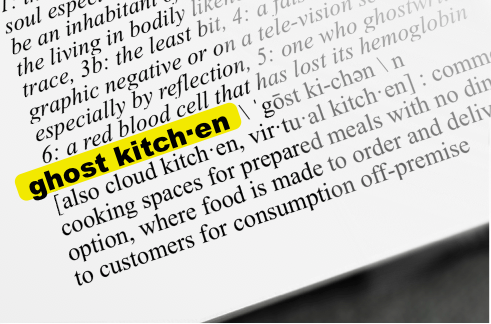A simple definition of ghost kitchen is
“commercial cooking space with no dine-in option” (QSR Magazine).
The concept derived from restaurants that wanted to increase their meal delivery capacity to meet demand without having to increase the size of their storefronts.
According to the National Restaurant Association, 60% of restaurant meals are consumed off-premise due in part to the rise in food delivery apps such as Uber Eats and Grubhub. Ghost kitchens act as hubs for food preparation and delivery, where restaurants share space much like a shared-use kitchen. In fact, many shared-use kitchens and their members are devoting some of their capacity to on-demand food delivery. It’s an ever-more-appealing prospect as the $17 billion U.S. online food delivery market climbs toward a projected $24 billion by 2023, according to data portal Statista (QSR).
Benefits of Ghost Kitchens
Opening a successful restaurant is often contingent on the location. We are accustomed to seeing an empty storefront cycle through different concepts, each one hoping to be the thing that sticks. And we all probably can name a favorite long-standing joint that folded because of rising rents. Restaurants, especially new ones still building a customer base, operate on thin margins. With occupancy costs for the average restaurant accounting for up to 6% to 10% of gross sales, ghost kitchens in lower-rent districts offer a more cost efficient option for growth.
Choosing to produce from a ghost kitchen is appealing to both large established chains and small family-owned restaurants. Ghost kitchens can expand a restaurant’s delivery zone to neighborhoods that have higher lease rates. Some restaurants utilize ghost kitchens as additional prep space during busier seasons. Some use them as a bench kitchen to experiment with new menu items or to test entire restaurant concepts and cultivate a customer base before turning concepts into brick and mortar restaurants.
Ghost kitchens of this type offer tenants infrastructure, commercial equipment and cold storage for a monthly fee. They may also provide services like dishwashing and food receiving, so the restaurants only need to hire cooks and kitchen prep staff. In addition, tenants can share wholesale delivery expenses.
Some ghost kitchens are not associated with physical restaurants. Also known as virtual kitchens or cloud kitchens, these spaces are used to produce meals for delivery-only restaurant concepts and are usually staffed by a crew managed by the owner of the kitchen. The biggest benefit of ghost kitchens may be the suitability of this particular model to the ever-expanding gig economy.
Ghost Kitchens and Technology
The ghost kitchen concept is scaling rapidly through investments from household Silicon Valley names. The most well-known is Kitchen United which secured a $10 million investment last year led by Google Ventures; they plan to open 400 facilities in the next few years (QSR). CloudKitchens launched with a $150 million investment led by the former Uber CEO. DoorDash has entered the market by opening its own set of virtual kitchens.
These brands aspire to become the WeWork of shared kitchens, operating in cities across the nation. Their business models are built on a cloud-based operating system that streams orders from restaurants and delivery platforms, and they benefit from existing awareness of the brand (like Uber Eats) resulting in increased sales.
Even though the ghost kitchen industry is relatively new, it is still evolving. Some operators are experimenting with mobile kitchens like Zume, that uses predictive analytics to determine demand, and precisely when and where to locate the vehicle to maximize sales.
Challenges for the Future
While the ghost kitchen concept continues to rapidly grow, there are skeptics that hope its sudden success is not short-lived, nor hurts the restaurant industry long-term.
- Steep Learning Curve – Some ghost kitchens are run by companies that have little experience operating (or building) a commercial kitchen, let alone a restaurant whose economics are much different than a tech company. At the same time, some of the restaurants moving into ghost kitchens have little experience managing delivery and/or off-premise sales. Each party will need to be flexible, establish strong lines of communication, and appropriately share the risk.
- Fair Pricing – Operators of ghost kitchens are attracted by the revenue potential, yet it is important that the restaurants they support also see revenue growth. Delivery apps like Uber Eats and Grubhub take 15 to as much as 30 percent commission on every order. While these percentages may not hurt more established concepts, operators need to build in options for smaller restaurants that do not push them out of business.
- Fair Treatment – Restaurants may lose some control of quality and intellectual property by working with a ghost kitchen. Therefore, they must demand fair terms and conditions in their contracts, carefully consider the pros and cons of handing over key operational duties to a third party, and contemplate what it will mean for their own businesses long-term (Forbes, Should Kitchens be Scared of Ghost Kitchens?).
—————
New Venture Advisors has been involved in business planning and design of shared-use commercial and incubator kitchens. We can see the potential for ghost kitchens to provide an additional source of revenue for kitchen operators and their members, which may make the challenges worth the experiment.
We anticipate the momentum of ghost kitchens to increase the inquiry into their feasibility. If you are planning a kitchen incubator space, we have a great free tool for doing some quick capacity modeling – head over to the Toolsite to use our Kitchen Facility HubSizerⓇ tool!



